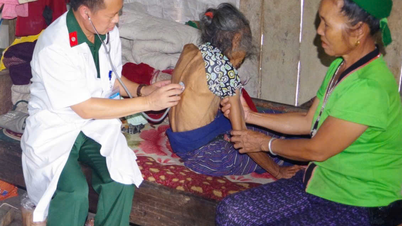Ensuring biosecurity in livestock farming is the most important "shield" to prevent African swine fever (ASF) from spreading. When an outbreak occurs, the drastic intervention of functional forces, as well as the awareness of disease prevention among livestock farmers, are fundamental solutions to control and prevent the spread of the disease.
The provincial Department of Animal Husbandry and Veterinary Medicine inspected and guided farmers in Da Bac district to implement measures to prevent the spread of African swine fever.
Livestock businesses "immune" to African swine fever
In the past 5 years (2019 - 2024), while ASF swept through and caused damage to household livestock farming, concentrated farm-scale livestock farming was "immune" to this dangerous disease. According to the Department of Agriculture and Rural Development, the province currently has 13 pig and gilt farms with a scale of 1,000 - 18,000 pigs, 17 breeding sow farms with a scale of 600 - 2,400 pigs. In addition, there are many small and medium-sized pig farms in the localities.
Japfa Company's pig farm in Mong Hoa commune ( Hoa Binh city) has a scale of 6 thousand sows. In recent years, this pig farm has not been damaged by ASF. According to Mr. Do Tien Khang, a representative of the company, to deal with ASF, disease prevention is the most important step. The company strictly implements disease prevention and control (PCDB) in general, including ASF. To do that, livestock farming must ensure biosecurity.
Japfa Company has divided the farm into many biosafety rings, each ring has its own separate area and disinfection area. Ring 1 is the garage area, the living area of the workers. Ring 2, when people, vehicles, and food are brought in, they are all disinfected with UV rays before entering ring 3 (the livestock area). Mr. Khang said that all warehouses and yards are equipped with disinfection and sterilization systems. Around the barns, the roof is sprayed with disinfectant, eliminating pathogens and insects that can enter the livestock area. During the epidemic, the company requires workers and technicians to stay on the farm for 3 months before being allowed to take a leave. After the leave, they must stay in a separate isolation area before returning to work. "The company strictly implements biosafety because if an epidemic occurs, it will be very difficult to control," Mr. Khang emphasized.
Thus, biosecurity is the "shield" to prevent DTLCP from entering. Biosecurity is understood as the synchronous implementation of technical and veterinary hygiene measures to prevent and limit the spread of pathogens from outside into livestock facilities and destroy pathogens existing inside the livestock facilities. Thereby preventing the penetration of pathogens from outside into the farm, preventing pathogens from spreading between livestock areas in the farm, and preventing livestock in the farm from getting sick. However, for mainly dispersed, small-scale household livestock, temporary barns have not been properly invested, making it difficult to implement biosecurity measures. Therefore, the authorities recommend that livestock farmers need to regularly clean barns, spray insecticides, pay attention to the steps in selecting breeds of clear origin, separate livestock areas from residential areas, and limit the entry of strangers...
Lessons learned
One of the current shortcomings in the prevention and control of ASF is that although the locality has declared an epidemic, it has not implemented synchronous measures according to regulations. The implementation of epidemic prevention and control in some communes in Da Bac district shows that the involvement of local authorities has not been really drastic. In the communes where the epidemic has been declared, there are no signs, no quarantine forces, and no control over the transportation of pigs and pork products in and out of the area. These are conditions for the disease to spread and are difficult to control.
In Yen Thuy district, ASF has occurred since 2019 and is still smoldering and persistent in some communes, especially in sow herds. Since the beginning of the year, Yen Thuy district has destroyed nearly 5 tons of pigs due to ASF. To overcome the difficulties arising after the merger of the Livestock and Veterinary Station into the Agricultural Service Center, the district has had effective measures to control the epidemic. Comrade Bui Thi Xanh, Deputy Head of the Department of Agriculture and Rural Development of Yen Thuy district, said: The District People's Committee has established a Steering Committee for ASF prevention and control; at the commune level, working groups have been established, including a team to monitor the destruction of ASF-infected pigs. For areas where the epidemic has occurred, the Department of Agriculture and Rural Development of the district has advised the District People's Committee to direct the communes to establish quarantine checkpoints with the participation of forces: police, market management. Thanks to that, the transportation and trading of pigs into areas where ASF is occurring has been prevented.
To improve the effectiveness of ASF prevention and control, Mr. Vuong Dac Hung, Deputy Director of the Department of Agriculture and Rural Development, said: Early detection of outbreaks and immediate implementation of strict measures to localize and completely suppress the epidemic with the motto "where the epidemic occurs, it must be thoroughly handled there" is very important. Localities must declare the epidemic and declare the end of the epidemic in accordance with the Law on Veterinary Medicine to mobilize resources and human resources to carry out epidemic prevention and control activities according to regulations. At the same time, the Steering Committee for Animal Disease Prevention and Control must be strengthened to direct decisively and assign clear and specific tasks to members in charge of each field and each locality to organize the implementation of measures to localize and suppress the epidemic.
In addition, assign responsibility to the heads of local Party committees and authorities if an epidemic occurs or spreads due to negligence, subjectivity, or lack of responsibility in the area. Establish temporary animal quarantine checkpoints or mobile teams to prevent and control epidemics to strictly control the slaughter of pigs, the consumption of pork and pork products in epidemic areas; stop vehicles to clean and disinfect vehicles entering and leaving epidemic areas. Conduct statistics, review, and monitor publicly and transparently (especially in the destruction of animals) to strictly control the epidemic situation. Implement "4 on-site", including: on-site forces, on-site resources, timely on-site support, and on-site logistics.
In addition, it is necessary to carry out propaganda work well in many forms to let people know about the harmful effects of the epidemic so that they can proactively coordinate; strictly handle violations of animal disease prevention and control regulations. The Deputy Director of the Department of Agriculture and Rural Development emphasized that close coordination between functional agencies is an important factor to promptly and effectively implement epidemic prevention work.
Source






![[INFOGRAPHIC] Open-back headphones, look like a... pill](https://vphoto.vietnam.vn/thumb/1200x675/vietnam/resource/IMAGE/2025/7/16/cd63f007ad404018aa504c1009ce19ba)






























































































Comment (0)